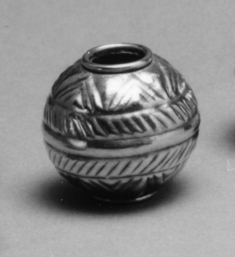Biconical Bead
This large biconical gold bead (along with Walters 57.453) was worked first in repousssé and then chased, using a hammer, chisel, and punches on the sheet metal to create an etched or engraved effect. The beads were probably strung with similar ones of slightly varying sizes to create a choker or a long necklace.
Provenance
Provenance (from the French provenir, 'to come from/forth') is the chronology of the ownership, custody, or location of a historical object. Learn more about provenance at the Walters.
Joseph Brummer, Paris and New York, [date and mode of acquisition unknown] [as part of the so-called "Jugoslavian Treasure"]; Henry Walters, Baltimore, 1927, by purchase; Walters Art Museum, 1931, by bequest.
Exhibitions
| 2010 | Bedazzled: 5,000 Years of Jewelry. El Paso Museum of Art, El Paso. |
| 2006-2009 | Bedazzled: 5,000 Years of Jewelry from the Walters Art Museum. Frist Center for the Visual Arts, Nashville; The John and Mable Ringling Museum of Art, Sarasota; The Walters Art Museum, Baltimore. |
| 1979-1980 | Jewelry - Ancient to Modern. The Walters Art Gallery, Baltimore. |
Conservation
| Date | Description | Narrative |
|---|---|---|
| 12/12/1978 | Examination | examined for condition |
Geographies
Italy (Etruria) (Place of Origin)
Measurements
H: 1 1/8 in. (2.9 cm)
Credit Line
Acquired by Henry Walters, 1927
Location in Museum
Not on view
Accession Number
In libraries, galleries, museums, and archives, an accession number is a unique identifier assigned to each object in the collection.
In libraries, galleries, museums, and archives, an accession number is a unique identifier assigned to each object in the collection.
57.452



